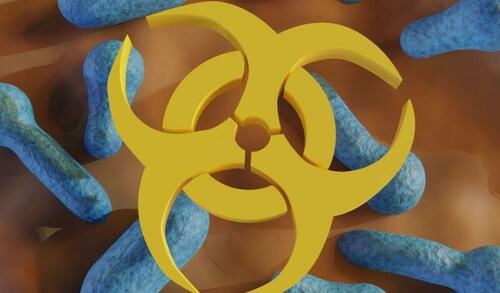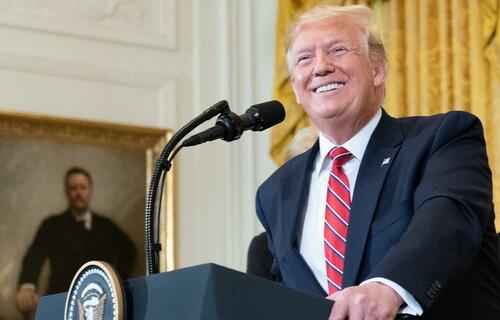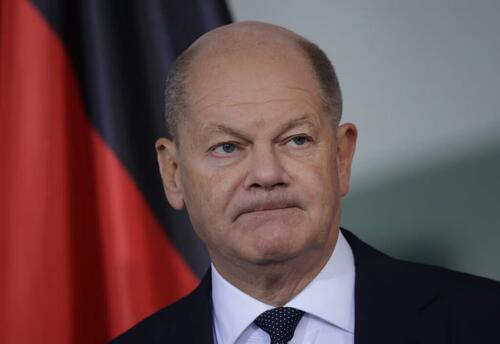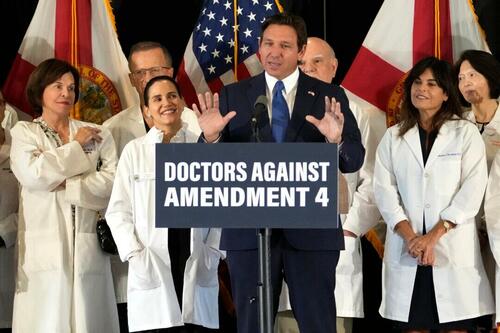Authored by Robert Malone via The Brownstone Institute,
Highlights
-
Political disinformation was positively associated with respiratory infection incidence.
-
Government-sponsored disinformation was positively associated with the incidence of Covid-19.
-
Internet censorship led to underreporting of the incidence of respiratory infections.
-
Governments must stop sponsoring disinformation to avoid blame or gain a political advantage.
The recent report from the US House Energy and Commerce Committee titled “We Can Do This: An Assessment of the Department of Health and Human Services’ COVID-19 Public Health Campaign” provides detailed, documented information concerning the public Covid-19 PsyWar/Propaganda disinformation campaign delivered by the “Fors Marsh Group” corporation for the US Department of Health and Human Services. This was previously discussed in this Substack essay.

According to the documentation provided, the principal HHS partner cooperating with Fors Marsh to provide content and messaging guidance regarding approved Covid-19 interventions was the US Centers for Disease Control and Prevention (CDC). The report conclusions and appendix include data summaries implying that this nearly one billion dollar campaign ($911,174,285) contributed to the development of widespread US citizen resistance to Covid-19 “vaccine” uptake, and was associated with deterioration in confidence concerning the CDC, the public health enterprise, and vaccines.
The Fors Marsh campaign specifically and intentionally deployed fear-based messaging to influence public behavior to comply with CDC and other USG recommendations. The intentional promotion of fear of death from an infectious disease disproportionate to actual risk of death is psychological bioterrorism and is associated with significantly greater social, political, and economic damage than that associated with known actual bioterror events such as the US Anthrax spore letter distribution campaign.
The weaponization of fear of death from an infectious disease as a component of an intentional propaganda campaign designed to modify human behavior is morally abhorrent, and is associated with a wide range of direct economic and mental health harms. These harms were never considered during the development and deployment of this HHS-sponsored psychological warfare technology-based propaganda campaign. This type of messaging and propaganda meets the criteria of State-sponsored disinformation.
In contrast to misinformation, which refers to simply false information, disinformation refers to false information that is spread deliberately to deceive people. Unsurprisingly, political leaders, especially those who have undermined democratic institutions, adopt disinformation as an instrument for gaining support and reducing resistance, especially during crucial political moments such as elections and wars (Guriev and Treisman, 2019).
From the Energy and Commerce Committee report page 42:
The CDC’s disregard for emerging evidence that contradicted its own preferred policy outcomes demonstrates an insular culture unable—and unwilling—to change course with evolving science. By November 10, 2021, in line with ACIP’s recommendation, the Campaign began airing ads targeting parents of children aged 5-11 years. These ads inaccurately suggested children were at high risk of severe illness or death from COVID-19. Many ads were emotionally manipulative and sought to incite fear by exaggerating the risk of severe illness and death among low-risk populations, such as children. This was especially true of ads that targeted parents. At the same time, the ads played down vaccine associated risks.
From pages 45-46:
Nine months later, faced with a surge driven by the Delta variant, the Biden-Harris administration reneged on its pledge and announced, in a nationwide primetime address, that it would impose Covid-19 vaccine mandates. President Biden stated that “in total, the vaccine requirements in my plan will affect about 100 million Americans.” He ominously warned unvaccinated Americans or those who had only received a single dose, that “[w]e’ve been patient, but our patience is wearing thin.” The mandates were presented as a way to protect higher-risk vaccinated workers and those too young to be vaccinated from catching Covid-19 spread by unvaccinated individuals.
At the time of the announcement, over 175 million Americans were vaccinated with about 80 million Americans remaining unvaccinated. The vast majority of unvaccinated individuals were under the age of 50 and at comparatively low risk of severe illness and death. More importantly, at that time, over 85 percent of people over 65 years old had received one dose, and around 78 percent had completed the two-shot primary series. Similarly, over 75 percent of people 50-64 years old had received at least one dose. Thus, the age groups at highest risk of severe illness or death were largely already vaccinated by the time the mandates were announced.
From page 62:
The fact that HHS’s COVID-19 pandemic policies, guidance, and recommendations, including Campaign messaging, were grounded in incorrect data generated by a faulty algorithm that had inflated the number of COVID-19 deaths shattered HHS’s remaining credibility. The CDC’s admission to overcounting deaths undermined the Campaign’s promotional materials. The Campaign’s messaging pressured parents to believe their children were facing life-or-death scenarios. By using artificially inflated child mortality rates, the Campaign greatly overstated the threat facing children and struck unnecessary fear into households everywhere. Parents felt betrayed, and those who resisted or tuned out the warnings felt vindicated.
Quoting for the report appendix:
Over and over, the Campaign’s survey findings showed little to no change in vaccine uptake or readiness among the public. In spite of heavy promotion, findings reveal vaccine uptake remained unchanged for nearly a year between August 2021 and June 2022.
By April 2022, 76 percent of unvaccinated adults said they would never get a COVID vaccine.
Among unvaccinated adults, nearly half of all those surveyed remained unvaccinated due to concerns about the long-term side effects of the vaccines. Others remained concerned about the speed with which the vaccines were developed, their efficacy in preventing COVID infection and transmission, as well as mistrust of government motives in widely encouraging vaccines.
Survey findings between January and June 2022 also reveal no significant change in booster uptake among fully vaccinated adults. Notably, survey findings also reveal that while the Campaign was ongoing, booster uptake peaked at 27 percent in November 2021 and gradually declined to 3 percent in March 2022.
The Campaign closely monitored vaccine hesitancy among the public, including among parents of children under 18 years. A CET survey finding from March 2022 showed between 60 and 76 percent of parents with unvaccinated children under 18 years were concerned about potential vaccine side effects. At the same time, 53 percent of adults agreed that parents should be able to make their own choices about getting their children vaccinated, and as the COVID pandemic lagged, Campaign findings indicated a 20 percent drop in the number of adults who supported mask mandates in schools over a seven-month period. Interestingly, school mask and vaccination mandates for teachers, staff, visitors, and students were most strongly supported by liberal, vaccinated adults, non-parents and those dwelling in urban areas. In contrast, parents were more likely to agree that COVID vaccines for young children, especially those under 5, were unnecessary.
By 2022, many Americans had had enough. In April 2022, nearly half of all surveyed adults agreed that vaccination and masking decisions are personal choices and should not be mandated. These statistics reveal how public perception significantly diverged from that of the Biden-Harris administration and the Campaign’s messaging. Demonstratively, when the federal mandate requiring masks in airports and on airplanes, buses, subways, trains, and other forms of public transportation was scheduled to expire on April 18, 2022, the CDC, and the Transportation Security Administration (TSA) chose to extend it another two weeks—until May 3. Although major airlines such as Delta and American Airlines called to an end to the requirement, President Biden “promised to veto any legislation overturning it.”
By April 2022, 58 percent of adults surveyed stated they were tired of worrying about the risk of COVID and 46 percent claimed they tune out COVID related news. Fifty percent stated, “[t]he virus may not be done with us, but we need to be done with it.”
In short, the campaign failed to achieve the intended objectives and instead was associated with the development of widespread citizen distrust and disillusionment with the State, the CDC, the US Public Health Enterprise, the Medical/Industrial complex, and vaccines in general.
Not considered and unaddressed in the Energy and Commerce report was whether these types of State-sponsored infectious disease disinformation campaigns positively or negatively influence infectious disease outbreak outcomes. I used the US National Library of Medicine PubMed search engine to investigate this question to discover whether any high-quality peer-reviewed academic research addressing the issue had been published.
My search revealed a March 2022 study publication by a group of Taiwanese researchers that was published in the Elsevier journal Social Science and Medicine. Is this journal a respected academic publication?

Social Science and Medicine Impact Score (IS) Trend:
-
The Impact Score for Social Science and Medicine has been steadily increasing over the years, with a slight decrease in 2023 to 5.38.
-
The highest Impact Score recorded in the last 10 years is 5.54 (2022), while the lowest is 3.22 (2018).
-
According to SCImago Journal Rank (SJR), Social Science and Medicine is ranked 1.954, indicating a high level of scientific influence.
Clearly “Social Science and Medicine” is a credible peer-reviewed academic journal.
The article is titled “Government-sponsored disinformation and the severity of respiratory infection epidemics including COVID-19: A global analysis, 2001–2020”
This link will take you directly to the publication, which is published as an open source document (no subscription required). But you will need to verify that you are a human. It is not too technical, and I recommend that any readers seeking additional details (such as experimental methods and data) read the primary source.
Both the background summary and the study findings are prophetic, and almost completely aligned with the Energy and Commerce committee report.
Abstract
Internet misinformation and government-sponsored disinformation campaigns have been criticized for their presumed/hypothesized role in worsening the coronavirus disease 2019 (COVID-19) pandemic. We hypothesize that these government-sponsored disinformation campaigns have been positively associated with infectious disease epidemics, including COVID-19, over the last two decades. By integrating global surveys from the Digital Society Project, Global Burden of Disease, and other data sources across 149 countries for the period 2001–2019, we examined the association between government-sponsored disinformation and the spread of respiratory infections before the COVID-19 outbreak. Then, building on those results, we applied a negative binomial regression model to estimate the associations between government-sponsored disinformation and the confirmed cases and deaths related to COVID-19 during the first 300 days of the outbreak in each country and before vaccination began.
After controlling for climatic, public health, socioeconomic, and political factors, we found that government-sponsored disinformation was significantly associated with the incidence and prevalence percentages of respiratory infections in susceptible populations during the period 2001–2019. The results also show that disinformation is significantly associated with the incidence rate ratio (IRR) of cases of COVID-19. The findings imply that governments may contain the damage associated with pandemics by ending their sponsorship of disinformation campaigns.
Introduction
Coronavirus disease 2019 (COVID-19) has caused a worldwide medical crisis that began in 2020. As the COVID-19 pandemic has escalated, accurate and inaccurate information has spread on the Internet (Islam et al., 2020). The World Health Organization (WHO) has warned of the risk of an “infodemic” wherein an overwhelming amount of circulating information discredits professional advice and prevents accurate information from reaching its target audience (WHO, 2020). Some studies have found that people’s exposure to misinformation may be associated with their violation of epidemic prevention regulations or resistance to vaccination (Lee et al., 2020; Hornik et al., 2021; Loomba et al., 2021; Prandi and Primiero, 2020), and the sources of this misinformation can be traced back to political leadership in the government. For example, one study found the name of former U.S. president Donald Trump appeared in 37.9% of misinformation conversations about the COVID-19 pandemic (Evanega et al., 2020). These findings imply that attempts to conceal or distort information about the disease may contribute to its spread globally.
Most public health studies on information issues have emphasized only the spread and effects of misinformation (Roozenbeek et al., 2020) and not considered “disinformation.” In contrast to misinformation, which refers to simply false information, disinformation refers to false information that is spread deliberately to deceive people. Unsurprisingly, political leaders, especially those who have undermined democratic institutions, adopt disinformation as an instrument for gaining support and reducing resistance, especially during crucial political moments such as elections and wars (Guriev and Treisman, 2019). In the digital era, recent studies have uncovered that more than two dozen governments have been deeply involved in disinformation campaigns to pursue their own domestic or international purposes (Bennett and Livingston, 2018; Bradshaw and Howard, 2018).
The relationship between such disinformation campaigns and disease spread warrants investigation particularly in the case of the COVID-19 outbreak. Some governments adopt authoritarian strategies including disinformation and censorship to protect against political accountability and criticism over the spread of epidemics. However, the effects of such activities are unclear (Edgell et al., 2021). In this paper, we hypothesize that political disinformation may lead to worse public health outcomes. By examining comprehensive data on respiratory infections from 149 countries from 2001 to 2020, the present study discovered that government-sponsored disinformation is positively associated with the spread of respiratory infections including COVID-19. The findings imply that governments may contain the damage associated with pandemics by ending their sponsorship of disinformation campaigns.
Disinformation is widely understood as being misleading content produced to further political goals, generate profits, or maliciously deceive. It may be utilized by politicians to manipulate public perception and reshape the collective decisions of the majority (Stewart et al., 2019). As an effective political tool in the digital era, one of the major origins of disinformation is a variety of agents sponsored by governments (Bradshaw and Howard, 2018). The actors disseminating government-sponsored disinformation include government-based cyber troops working as civil servants to influence public opinion (King et al., 2017), politicians and parties utilizing social media to reach their political intentions, private contractors hired by the government to promote domestic and international propaganda, volunteers that collaborate with governments, and citizens who have prominent influence on the internet and are paid by governments to spread disinformation (Bennett and Livingston, 2020).
Accompanied by the development of the internet, government-sponsored disinformation has become a global issue over the last two decades. Comparative political studies have noted that autocracies create more fake news than democracies, while the public in democracies has also severely suffered from it (Bradshaw and Howard, 2018). In contrast to democratic governments that are elected to provide public goods through majority rule, nondemocratic governments have leaders who remain in office by gaining support from a small group of political elites without checks and balances. Autocratic governments, therefore, face the constant threat of mass protests from large numbers of disenfranchised people (De Mesquita and Smith, 2003; Acemoglu and Robinson, 2006). In the digital age, autocracies prefer to use informational instruments such as censorship and disinformation to compromise potential protests, particularly during political crises (Guriev and Treisman, 2019). For example, a recent study revealed that autocracies such as China, Russia, and Iran used internet censorship as a reactive strategy to suppress civil society after the Arab Spring (Chang and Lin, 2020).
The political effects of government-sponsored disinformation and internet censorship on disease spread, however, remains understudied. As a tool for maintaining political stability in the government’s favor; however, disinformation may lead to dysfunction in public health systems, as well as more infections from disease. In this paper, we highlight some suspected political, informational, and institutional processes to explain the positive association between government-sponsored disinformation and the exacerbation of infectious diseases—measured by the incidence, prevalence, and death percentages of respiratory infection before the COVID-19 pandemic—and how this disinformation was associated with the number of confirmed cases (henceforth, cases) of and deaths due to the COVID-19 pandemic.
As the COVID-19 outbreak has made apparent, some government incumbents accountable for controlling the disease neglected the risk and failed to prevent its spread. The failure of leadership to control the disease stimulated blame avoidance behaviors (Weaver, 1986; Baekkeskov and Rubin, 2017; Zahariadis et al., 2020), which sometimes took the form of internet censorship and government-sponsored disinformation. The Chinese government has been criticized for its alleged ignorance and suppression of information at the beginning of the COVID-19 epidemic (Petersen et al., 2020), while Chinese diplomats have openly accused the United States of spreading the disease, with the Iranian and Russian governments also supporting this conspiracy theory (Whiskeyman and Berger, 2021). In Iran, the government disseminated contradictory information on national COVID-19 fatalities. On February 10, 2020, the Iranian government falsely claimed that the country had no cases of coronavirus, but a 63-year-old woman died of COVID-19 on the same day. Finally, on February 19, the Iranian regime admitted that coronavirus had spread in Iran, 9 days after the first reported death (Dubowitz and Ghasseminejad, 2020). Under the cloud of poor transparency and disinformation regarding the epidemic in Iran, the country saw severe outcomes, with 55,223 deaths as of December 31, 2020.
Disinformation as blame avoidance behavior by political leaders was exhibited not only in autocratic countries, but also occurred in some democratic countries (Flinders, 2020). For example, during his US presidency, Donald Trump understated the risk of the COVID-19 pandemic by accusing the political opposition of conspiracy and the media of exaggeration (Calvillo et al., 2020). His statements about hydroxychloroquine as a “miracle cure” also misled the public to employ false treatments (Evanega et al., 2020). This misinformation about the disease could directly result in ineffective coping by people and undermine their institutional trust in public health agencies. However, the suspected “disinformation” from democratic leadership, in contrast to autocracies, still encountered effective checks and balances by parliaments, medical professionals, free media, and voters.
Some case studies have shown that reliable and transparent government-sponsored epidemic information could have alerted public health institutions and susceptible populations early and led them to take effective preventive behaviors before the COVID-19 pandemic. For example, a key lesson learned from the severe acute respiratory syndrome (SARS) experience in Singapore was the importance of rapid and accurate information to support effective decision-making. The innovation of frequent information reviews effectively guided local public health decisions during the H1N1-2009 epidemic (Tan, 2006; Tay et al., 2010).
In contrast, government-sponsored disinformation disrupts the mechanisms of information exchange among public health institutions and other bodies, which can lead to ineffective coping, such as perceptions of low risk and the slow development of preventive behaviors at both the individual level, and preparedness delays and resource misallocation at the institutional level. COVID-19 studies have demonstrated that people’s belief in misinformation reduced the likelihood that they would take preventive measures such as mask wearing, social distancing, and complying with official guidelines (Lee et al., 2020; Hornik et al., 2021; Pickles et al., 2021). Case studies of Iran have revealed that government-sponsored disinformation typically results in ineffective coping by individuals and public health institutions and that the disinformation can elevate disease incidence and prevalence in an epidemic (e.g., Bastani and Bahrami, 2020).
In addition, in contrast to democracies, autocracies such as Iran, China, Russia, and North Korea are likely to refuse information sharing and regulations promoted by the global health system during a pandemic (Burkle, 2020). When governments disseminate disinformation or suppress valid information, therefore, we expect that it is difficult for public health institutions and citizens to protect themselves from the spread of the disease.
Misinformation is likely to trigger institutional distrust in public authorities and thus directs citizens’ attention away from professional advice and instead towards skeptics and harmful treatments (Brainard and Hunter, 2019) harmful treatments (Brainard and Hunter, 2019). Disinformation could be associated even more strongly with dire outcomes. Studies conducted before the COVID-19 pandemic have illustrated that distrust of government or the medical profession creates obstacles to preventing epidemics by reducing people’s compliance with official messages related to disease containment and by engendering inadequate medical service utilization. For example, studies investigating Ebola outbreaks discovered that respondents with misinformation and low trust in the government were less likely to comply with social distancing policies or take precautions against the epidemic (Blair et al., 2017; Vinck et al., 2019).
Recent global studies on COVID-19 have reported that trust in public institutions, but not general social trust, has a negative association with the disease incidence ratio and deaths related to the pandemic (Elgar et al., 2020). For example, online survey studies confirmed that trust in government amplified compliance with official health guidelines (Pak et al., 2021); evidence from a geographic information system in European countries revealed the same pattern—the higher the political trust, the lower the regional and national human mobility (Bargain and Aminjonov, 2020). Survey studies conducted in both China and Europe have demonstrated that higher political trust before the outbreak was associated with lower incidence and mortality rates (Ye and Lyu, 2020; Oksanen et al., 2020). In addition, studies conducted in the United States have shown a negative relationship between institutional trust in science and the public health system and belief in misinformation (Dhanani and Franz, 2020; Agley and Xiao, 2021) and that both trust and information sources influence the probability that individuals will perform preventive behaviors (Fridman et al., 2020). International comparative studies have also found that distrusting citizens may not comply with regulations because of their underestimation of the risk of non-compliance (Jennings et al., 2021).
Therefore, government-sponsored disinformation may result in distrust of public health institutions and be positively associated with the incidence and prevalence of disease. In this study, cross-national data on vaccination is not included, although other studies suggest that misinformation could result in the spread of epidemics by reducing the willingness to receive vaccination. Studies before COVID-19 have revealed that vaccination-related information on Twitter is associated with regional vaccination rates in the United States and public confidence in vaccination in Russia (Salath´ e and Khandelwal, 2011; Broniatowski et al., 2018). Based on a global survey, Lunz Trujillo and Motta (2021) found that country-level internet connectivity is associated with individual-level vaccine skepticism. A recent study on the acceptance of COVID-19 vaccines also demonstrated that misinformation exposure significantly reduced the willingness of people to accept a vaccine in the UK and USA (Loomba et al., 2021). As these studies implied, government-sponsored disinformation may reduce the acceptance and coverage of vaccination and thus are likely to be positively associated with the incidence and prevalence of epidemics. To sum up, blame avoidance and other interests of politicians may stimulate government-sponsored disinformation and internet censorship efforts during epidemics.
The disinformation might be associated with ineffective coping by people and institutions, and contribute to institutional distrust of governments and public health systems. The ineffective coping, and resistance to official guidelines of preventive behaviors and vaccination because of the distrust, might facilitate the spread of disease in epidemics. Accordingly, we expect government-sponsored disinformation to be positively associated with the incidence and prevalence measures of respiratory infections including COVID-19.
Conclusion
This study hypothesized a positive association between political disinformation and its impacts on epidemics in light of political and institutional processes. The findings reveal that government-sponsored disinformation is associated with the incidence and prevalence of respiratory infections during the period 2001–2019, before the COVID-19 pandemic. Government-sponsored disinformation is also positively associated with the IRR of cases of COVID-19 before vaccination program implementation. In contrast to literature focusing only on the effects of misinformation and preventive behaviors at the individual level during the COVID-19 pandemic, the present study integrated evidence from global surveys and revealed the adverse effects of government-sponsored disinformation on the management of epidemics over the last two decades. We found that disinformation is positively and significantly associated with the incidence and prevalence of respiratory infections including COVID-19, though its positive relationship with mortality of these respiratory infections was not significant. This study has some limitations. First of all, the disinformation index focused on only government sources and not on other disinformation and misinformation sources. Also, the DSP database is expert-rated and inevitably subjective.
However, it is the only existing global database regarding the interaction between politics and social media. Second, the pooled category of respiratory infections and the percentages of all disease causes could not be directly compared with the IRRs for a single pandemic. Data on both cases and deaths in the GBD and COVID-19 databases might not only present the impacts of the respiratory infections but also reflect differing levels of capacity among various public health systems and transparency among governments. The data on respiratory infections may be censored deliberately or underreported unintentionally by developing countries. For the application of the GBD database, we suggest that adopting the percentages of a specific type of epidemic from all causes might be a relatively more reliable choice than the rates or numbers. However, the database of epidemics might consider some adjustments to address the variation from the different capacity of public health systems.
Despite these limitations, this study may be the first to present cross-national evidence of the association between political disinformation and the spread of epidemics including COVID-19. Our study also implies that the quality of data during the COVID-19 pandemic is an endogenous factor of informational politics. The internet censorship of autocracies tends to systematically underreport the morbidity and mortality of the pandemic. Iran is a vivid example of intentionally underreporting and also disseminating fake news. There is also evidence of deliberate inaccuracies and concealment of COVID-19 infections in lower- or middle-income countries (Richards, 2020). Rocco et al. (2021) revealed that subnational COVID-19 data quality, including mortality, is associated with media independence. Hansen et al. (2021) pointed out that in the United States, counties were more likely to release information about COVID-19 when there was a stronger opposition (Democrats) before the US presidential election. In our analysis, governments that applied censorship and spread fake news as blame avoidance behaviors may also intentionally underreport the numbers of infected and deaths. After all, concealing the numbers of cases and deaths during the pandemic is also a form of political disinformation. Therefore, we may have underestimated the association between disinformation and the severity of pandemics. The real damage of disinformation may be greater than the current findings show.
Based on our findings, we suggest countering disinformation during the COVID-19 pandemic. First, we would ask that governments immediately stop sponsoring disinformation for blame avoiding or regarding the disease as a strategy for gaining political advantage in domestic and international conflicts. Also, we would propose that the international community and global civil society act to prevent governments from sponsoring disinformation campaigns and internet censorship. In practice, fact-checking authorities managed by civil associations may be established to efficiently refute fake news.
Eliminating fake news in civil society may help curb the spread of infections. In sum, to control the pandemic, fighting disinformation can play a key role.
Republished from the author’s Substack










